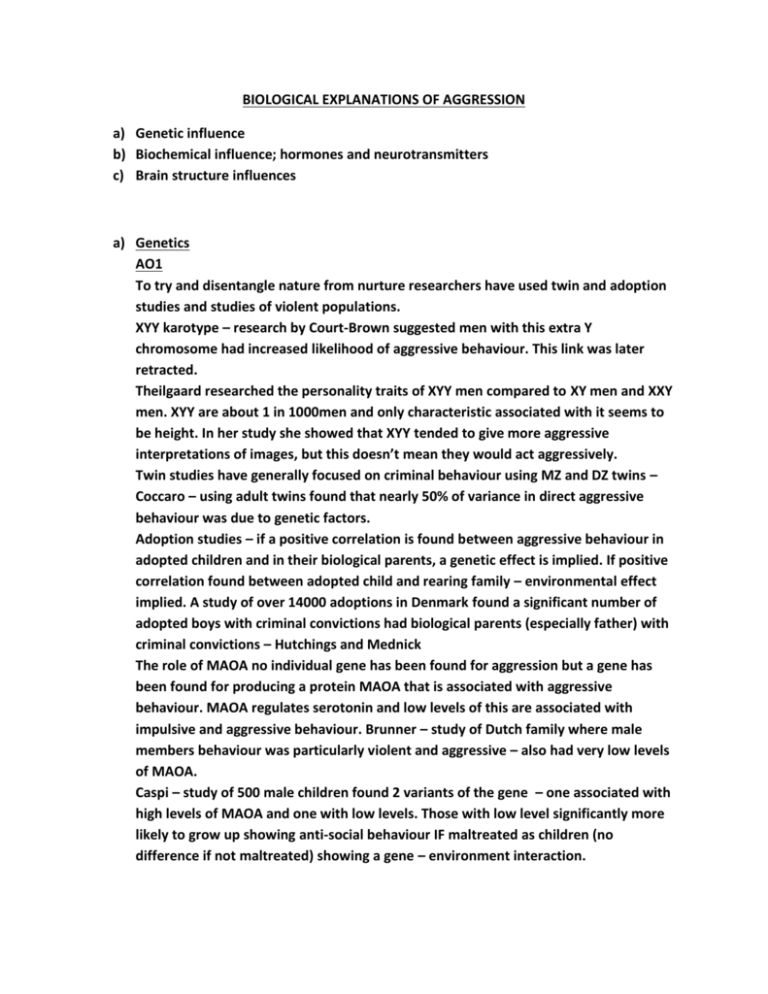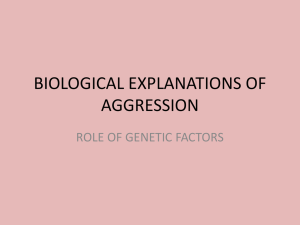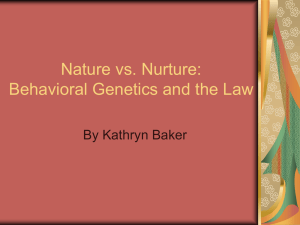Biological explanation of aggression genetics.doc
advertisement

BIOLOGICAL EXPLANATIONS OF AGGRESSION a) Genetic influence b) Biochemical influence; hormones and neurotransmitters c) Brain structure influences a) Genetics AO1 To try and disentangle nature from nurture researchers have used twin and adoption studies and studies of violent populations. XYY karotype – research by Court-Brown suggested men with this extra Y chromosome had increased likelihood of aggressive behaviour. This link was later retracted. Theilgaard researched the personality traits of XYY men compared to XY men and XXY men. XYY are about 1 in 1000men and only characteristic associated with it seems to be height. In her study she showed that XYY tended to give more aggressive interpretations of images, but this doesn’t mean they would act aggressively. Twin studies have generally focused on criminal behaviour using MZ and DZ twins – Coccaro – using adult twins found that nearly 50% of variance in direct aggressive behaviour was due to genetic factors. Adoption studies – if a positive correlation is found between aggressive behaviour in adopted children and in their biological parents, a genetic effect is implied. If positive correlation found between adopted child and rearing family – environmental effect implied. A study of over 14000 adoptions in Denmark found a significant number of adopted boys with criminal convictions had biological parents (especially father) with criminal convictions – Hutchings and Mednick The role of MAOA no individual gene has been found for aggression but a gene has been found for producing a protein MAOA that is associated with aggressive behaviour. MAOA regulates serotonin and low levels of this are associated with impulsive and aggressive behaviour. Brunner – study of Dutch family where male members behaviour was particularly violent and aggressive – also had very low levels of MAOA. Caspi – study of 500 male children found 2 variants of the gene – one associated with high levels of MAOA and one with low levels. Those with low level significantly more likely to grow up showing anti-social behaviour IF maltreated as children (no difference if not maltreated) showing a gene – environment interaction. May be no gene for violent crime but inherited temperament or personality may place some at more risk of committing violent crime. Adoption studies show highest rate of criminal violence in adopted children is when biological and adoptive parents have a history of violent crime. In other studies genetic influence only significant in cases of property crime not violent crime. AO2 i) ii) iii) iv) v) Very difficult to determine role of genes More than one gene normally contributed to a given behaviour Lot of non-genetic influences - reductionist The two may interact with each other – gene-environment interaction. Problems of assessing aggression Studies using parental and self reports of aggressive behaviour show higher genetic contribution than those using observations - methodological problems. See text book for e.g.s Studies often fail to distinguish between violent and non-violent crime therefore difficult to untangle genetic factors in aggressive behaviour and between habitual and one off violence. Walters – meta analysis only showed low to moderate correlation between heredity and crime, and modern better designed studies show lower correlations Problems of sampling. Studies have focused on individuals convicted of violent crime, relatively few are actually convicted so may not be representative of those involved in aggressive behaviour. Some convicted may be one off offenders rather than the most persistent. Despite weak evidence for biological base suggestions put forward to ‘treat’ those predisposed to violence e.g genetic engineering, and chemical castration. Ethical consequences of labelling someone a threat based on their genetic inheritance show why an awareness of the limitations of these studies is very important Lot of studies into aggressive behaviour has been done on animals often using selective breeding programmes and ‘knockout’ techniques. Young – claimed to have identified a genetic mutation that caused violent behaviour in mice. A counterpart of this gene does appear in humans although precise function unknown. a) Ethical issues involved with animal testing. b) Problem of generalising to human behaviour. Conclusions from animal testing might be limited when generalised to humans as aggression has cognitive implications which animals may not have. vi) vii) Practical application - Anger management courses. Determinism – Biological explanations of aggression are deterministic as it means people do not have free will over their behaviour. One implication is that if people are biologically determined then people cannot be held responsible for their aggressive behaviour.








